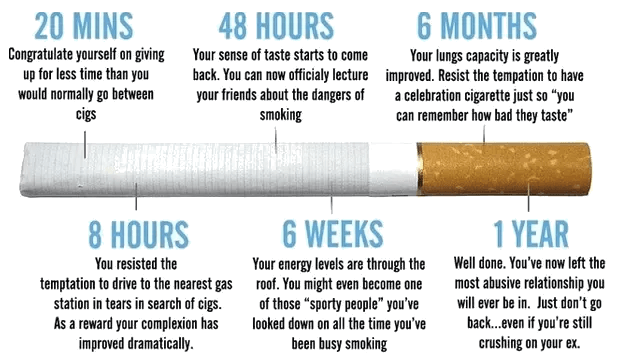
Hundreds of years ago, tobacco was introduced in Europe as a medicinal “cure-all”. It was later observed that the hazards of tobacco outweighed the claimed benefits, but political, economic and elitist influences weakened the arguments against it. Over time tobacco became the leading addictive recreational drug and the biggest preventable killer in the world. The annual death toll directly related to tobacco usage now stands at more than 6 million.
Tobacco is widely available without prescription, ownership is legal and society generally still regards it with less disdain than drugs like alcohol, cannabis, heroin, cocaine and meths. Despite its enormous impact on society as a whole, tobacco is not frowned upon with the same severity as those drugs, as it does not carry the same stigma and depth of personal destruction.
In fairly recent history, images of popular celebrities elegantly smoking in movies and media photos created perceptions of glamour in the minds of an adoring public. Tobacco smoking became a fashion trend, eagerly emulated by millions of fans. This led to the smoking fetish being passed on to younger generations who followed the example set by their parents and other predecessors.
Moreover, the enormously powerful tobacco industry moguls have always promoted their products very skillfully and vigorously. Some experts even accuse them of sneakily imposing numerous deceptions, distractions and false influences over decades.
Because of the cultured entrenchment and widespread acceptance of tobacco, its negative impact on society as a whole was historically ignored to a large degree. However, over the past decade awareness of the tobacco problem has increased dramatically.
Governments are progressively imposing more punitive laws and “sin taxes” to limit tobacco usage. Society views smokers with increasing disapproval. Business owners have become more sensitive to deploying it on their premises and are becoming more reluctant to employ smokers. Because of these initiatives, many addicts now want to quit smoking, but overcoming the addiction is a lot harder than it seems.
Most smokers can quit smoking for short periods, but long-term abstinence is not so easy to sustain. Mere force of habit is a challenge when you are used to reflexively reaching for a cigarette in certain situations. Filling that gap seems like a silly problem, but is more frustrating than one realises. More seriously, tobacco addicts start smoking again because of the post-withdrawal effects and because some of them gain unwanted body mass when they stop.
Another problem that hampers addicts, is the incorrect sentiment that it is “just a habit” that can be broken without professional health assistance. As a result, many see it as a process that only requires willpower. Unfortunately, treating it as a habit, instead of an addiction, and attempting self-healing, usually ends in either short-term failure or medium-term relapses.
It is well known that the most addictive ingredient of tobacco is nicotine, but keep in mind that tobacco also contains addictive caffeine and that one cigarette can release as many as 7,000 other chemicals. Recent studies indicate that some of the other chemicals also contribute to addiction. This may explain why over-the-counter nicotine-replacement remedies are often not helpful enough to break the addiction.
Tobacco companies are not simply making cigarettes, they are actually “engineering” it to increase the addictiveness. They even add chemicals that open up the lungs to increase the flow and volume of smoke that users inhale and absorb. Apart from the added ingredients, they also modify the design and material of the filters and the paper used. These “refinements” are made under the guise of improved quality, but actually translates into increased addiction and sales.
Because tobacco products are designed with the purpose of making them as addictive as possible, it has become harder to kick the habit than ever before, but quitting is definitely still possible with the help of health care professionals.
Ways to stop smoking
When you stop smoking the mental and physical side-effects can be fairly severe, but it can be avoided with medication. The following is a summary of cessation methods on offer to smokers:
Clinical hypnosis: Also known as hypnotherapy, this differs from other types of hypnosis, as it focuses on specific mental issues and must be administered by a certified clinical therapist to avoid conflict with other mental issues. The outcome is highly unpredictable – Sometimes it works, but often it does not.
Ear acupuncture: This uses needles to stimulate nerve points on your outer ear to correct problems in other parts of the body and nervous system. There are reports that it is effective for helping to stop addictions, but there is some scientific doubt about it. Consult a medical doctor before attempting this, as there are known medical conditions and interactions that can cause harm!
Auriculotherapy: Similar to ear acupuncture, but stimulation is done electronically with lasers, magnets or ear pellets. Its effectiveness has not been conclusively proven. Consult a medical doctor before attempting this, as there are known medical conditions and interactions that can cause harm!
Cold turkey: This is when a smoker stops smoking abruptly, relying on willpower alone, without medication or therapy. It is not recommended. The side-effects are unpredictable and can be dangerous. This method does not provide short or long-term security.
Gradual reduction: Most smokers believe they can gradually reduce their consumption on their own whenever they want to. The truth is that very few of them sustain it. It is not a sign of lack of character or willpower – Addiction is an overwhelming condition, beyond the control of most smokers.
Electronic devices: So called e-smoking devices, such as e-cigarettes, are aggressively marketed as tools to help reduce or stop tobacco smoking. They have fewer harmful ingredients than tobacco, but studies indicate that e-smoking is not an effective way to reduce the smoking problem. Most authorities have started regulating it.
Over-the-counter: Products that contain nicotine, bought without prescription, such as nicotine patches, chewing gums or lozenges. Known as nicotine-replacement products, they replace tobacco as the source of nicotine, but can maintain your nicotine addiction on their own. It reduces cravings and it can help with gradual withdrawal, but it does not bestow comprehensive coping skills.
Medical advice: Physical examination and advice by a medical doctor about side-effects and required medication for the smoker’s specific circumstances, is necessary. Most doctors also recommend therapy to prevent emotional incidents, help deal with transitional changes and to safeguard against relapses.
Prescription medicine: There are a number of controlled medications that a doctor can prescribe after a physical examination and a couple of questions aimed at determining the smoker’s personal condition and circumstances. These medications, some of which are not nicotine-based, alleviate the physical and mental withdrawals.
Counseling: Tailored cognitive and behavioural therapies provided by professional rehab centres enable ex-smokers to deal with emotions, weight problems, temptation, relapses and how to fill the gap when they are no longer able to reflexively reach for a habitual smoke.
Precautions: No matter what course you take to quit smoking, tell friends and family about it. Warn them that you may at times be rude or irritable and ask them to be patient. Ask them not to offer you cigarettes and not to smoke when you are with them.
Get support: Long-term abstinence can be strengthened with therapeutic treatment, but ongoing support remains a priority. Keep in touch with your therapist, enlist other ex-smokers as friends or join a support group.
Avoid cues: Stay away from events and places where there is a lot of smoking by others. Avoid alcohol and drugs, as they sponsor reckless behaviour and stimulate a craving for smoking. Never allow yourself “just one puff” – it proves nothing and is not worth any imagined reward.
Eat smart: With abstinence come improved taste sensations. It makes food more attractive. Find a diet that does not punish you. There is also a tendency to replace the act of frequent smoking with the act of snacking. Avoid junk snacks and nibble on sticks of lean jerky, carrots, celery, etc.
Physical exercise: Even light exercise, or just taking a brisk daily walk, will improve your mood, stimulate blood circulation, increase energy and help keep weight in line.
Other exercises: Meditation has been found to help for some people, but not for all. Breathing exercises are helpful for most quitters. Muscle relaxing exercises are good. Therapeutic treatment to improve cognitive thinking and behavioural disorders are proven effective remedies.
Be open-minded: The worst thing you can do in the face of a threat is to plant your head in the ground. Face the challenge of quitting with an open mind and seriously consider contacting an experienced addiction therapist for advice.
Counseling and prescription medication is the best combination for stopping tobacco addiction. Using both is more effective than using either one alone.
Why people smoke
Social acceptance: Many people start smoking due to pressure from other smokers. They smoke because they want to be accepted by a particular group, or because they want to please someone.
Experimentation: When people see others smoking and seemingly enjoying it, they are intrigued and start sampling tobacco products to see if they can gain the same satisfaction.
Availability: Tobacco is widely distributed and easily obtainable over the counter. Even where age restrictions are imposed, adolescents simply enlist older peers or use other tricks to obtain it.
Escapism: Tobacco releases brain chemicals that cause temporary feelings of well-being. It lures people into using it for temporary relieve from daily pressures.
Productivity: The energy boost provided by the chemicals are useful for increasing mental and physical abilities at times when people need to meet deadlines or up their game.
Personality traits: People who are unconventional, unorthodox, non-conformist, creative, risk takers, thrill seekers or rebels, tend to smoke tobacco as a sign of uniqueness or defiance.
Marketing: Sponsorships, philanthropy, influential brand names and other clever marketing techniques utilised by tobacco companies influence people to trust tobacco products.
Media: Celebrities who smoke in movies or on TV, especially in older productions, as well as photos of them, broadcast a message that smoking is an intellectual sign of elegance or superiority.
Role fulfillment: When smoking is common or condoned within a community or household, there is no incentive to avoid it and people succumb to a natural instinct to follow the herd.
Forbidden fruit: Many people desire something that is forbidden more than they desire something that is freely allowed. The generally forbidding attitude about tobacco actually encourages some to use it.
Bonding: When smokers meet and exchange small talk, they feel a sense of mutual acceptance and bonding. This cancels out the hostility and guilt that the anti-tobacco lobby invokes.
Self-titration: This is the ability to easily adjust the volume to fit your needs by simply puffing more or less fiercely, or by changing the frequency of puffs. It makes tobacco “user-friendly”. Smokers who change to less nicotine or tar content, often compensate by increasing the titration rate, thus neutralising the intended advantage – In fact, they suck in more of the other chemicals than they did before and end up being worse off.
Multipurpose: Tobacco offers different mental state options – Mild intake stimulates cognitive thinking, while heavy volumes induce sedation. In moderate volumes, smokers can be alert and calm at the same time. The multiple options increase its popularity.
Progression: Modern electronic smoking devices are punted as “healthier” alternatives to tobacco smoking, but instead it has become a gateway to tobacco.
Rapid delivery: Smoking, and the modern fad of “vaping”, is a rapid way to deliver nicotine to the brain. It works even faster than intravenous injection.
Addiction: Some smokers rely on the caffeine boost. Nicotine is even more addictive, as your body actually needs it, but stops making its own when you start smoking and becomes dependent on your tobacco intake. When you stop, the body can not immediately resume its own nicotine production and you get a withdrawal backlash.
Other drugs: Abusers of other drugs, like alcohol or illegal drugs, usually smoke. The same forces that trigger abuse of other drugs, drive tobacco abuse. The other drugs also induce recklessness and most of them stimulate cravings for smoking.
Gestural habit: Once smoking addiction has manifested, the act of “lighting up” becomes a reflex action in certain situations, establishing a force of habit that is difficult to break or replace.
Weight control: Smoking depresses appetite. Some smoke in an attempt to get the health benefits of slimming, in desperate defiance of tobacco’s greater health hazards. Others use it as an excuse to smoke.
Appearance: Some people associate being lean with being attractive, so they smoke to lose weight. They forget that smoking causes premature ageing, wrinkling and other conditions that make you less attractive. They have a high risk of acquiring eating disorders.
Boredom: Smokers are tempted to start or resume smoking when they have too much idle time. In idleness they allow distractive thoughts to invade their minds and they do not apply cognitive thinking.
Paradox construction: Smokers rationalise that they may as well smoke, as they could “die in an accident tomorrow” or that even non-smokers die of heart attacks and cancer, or that smoking toughens the body and enables it to recover better from illness, and similar self-defeating excuses.
Postponement: Smokers argue they are too loaded with work and other pressures to fit in the “burden” of quitting. They indirectly deny that, after a while, they will be able to cope better with those pressures after quitting.
Denial: Smokers exhibit denial by downplaying the positives of quitting and by promoting misleading urban myths. They insist they are in excellent health and would not feel any better if they quit, even though they do not really know how they will feel if they quit.
Biased optimism: Most smokers know the dangers of smoking, but do not believe that it will happen to them. It stems from a misapplication of our inherent need to perform our daily tasks without needlessly worrying about everything that could potentially go wrong.
Propaganda: When they repeat the same false information over and over, people eventually believe their own lies. Smokers fall foul of this by repeatedly trying to convince others or themselves of their misleading “reasons” for smoking.
Self-medication: Tobacco is easy to obtain and use as self-medication for inducing temporary feelings of well-being and to ward off the withdrawal effects. Alternative over-the-counter nicotine replacements are also used as ineffective self-medication to quit smoking.
Avoiding withdrawals: The withdrawal reactions when you stop smoking are mentally and physically unpleasant. Addicts smoke to avoid the withdrawal symptoms, which include:
- A strong craving for tobacco.
- Nervousness, anxiety, depression.
- Irritability, impatience, anger.
- Frustration, restlessness, insomnia.
- Headache, poor concentration.
- Dizziness, constipation, nausea.
- Increased appetite, weight gain.
- Desperation, risky behaviour.
The dangers of smoking
Passive smoking: Non-smokers also suffer from the effects of smoking by breathing in tobacco fumes in the vicinity of smokers. Exposure to passive smoking by family, friends and co-workers can cause respiratory problems, cancer and heart disease in non-smokers.
Negative behaviour: Research shows that smokers are more likely to abuse alcohol and other drugs, or to develop high-risk behaviour disorders.
Chasing a high: Nicotine is very addictive and over time you have to smoke more and more to get the same results. This leads to nicotine over-consumption, which causes more severe withdrawals when you stop.
Retardation: There is some evidence that smoking may harm brain development in young people, especially intelligence, memory and learning capacity, but it has not been conclusively proven.
Financial cost: Although less expensive than hard drugs, smoking is still relatively expensive and the cost is driven up by increased health problems.
Odours: You and your clothes, even your entire house and your car, will smell of tobacco smoke.
Psychological effects:
Pleasant effects:
- Euphoria, calmness, clarity.
- Improved attention and memory.
- Improved mental stamina.
- Sedation.
Co-morbid effects:
- Anxiety, depression.
- Bipolar disorders.
- Schizophrenia.
- Restlessness, fatigue.
- Impatience, volatility.
- Attention deficit disorders.
- Traumatic stress disorders.
- Desire for other drugs.
There is no fixed guide about whether the co-morbid effects derive from smoking, or the other way around. Consensus is that it differs from case to case. For instance, a person may have had depression first, which then drove them to using tobacco, but it could have happened in reverse order. Schizophrenia and traumatic stress disorder are exceptions, as they usually precede the desire for smoking.
The initial pleasant effects are actually problems. The psychological desire for it can last for years after cessation of smoking. Due to this, psychotherapy is required for long-term resistance to relapses.
Physical effects:
- Low body temperature.
- Sinus pressure, headaches.
- Airway infection, chronic coughing.
- Greyish skin tone, dull complexion.
- Premature ageing and wrinkling.
- Stained fingers and finger nails.
- Poor sense of smell, poor appetite.
- Impotence, sperm defects, infertility.
- Poor night vision, cataracts, blindness.
- Ragged breathing, chronic bronchitis.
- Insomnia, fatigue, decreased activity.
- Muscle deterioration, enlarged belly.
- Fragile bones, tooth decay.
- Gum disease, bad breath.
- Ear infections, hearing loss.
- Weakened immune system.
- Tuberculosis, emphysema.
- Slow healing wounds.
- Rheumatoid arthritis.
- Cardiovascular diseases.
- Pneumonia, diabetes.
- Cancer, heart attacks.
(Withdrawal symptoms are not included here.)
Notes:
It is said that external nicotine applications, like nicotine patches, may possibly be harmless, but there is no hard evidence to support these opinions. The available evidence shows that any nicotine loading is bad.
Although tobacco feeds you thousands of toxic chemicals, a popular slogan that concisely sums up tobacco’s danger, is: “The nicotine makes you an addict, the tar kills you”. However, the cancer-causing chemicals in tobacco, called Tobacco Specific Nitrous Amines, are just as deadly.
The most prevalent causes of death related to tobacco smoke are cardiovascular diseases, chronic obstructive pulmonary diseases and several types of cancer, especially lung cancer.
How cigarettes are engineered
The Filter: Its purpose is to filter out, or reduce, some of the ingredients, but modern filters are designed to prevent a minimal volume of ingredients.
The Tip Paper: The paper wrapping of the filter has small vent holes in it to allow fresh air to mix with and dilute the smoke when you suck on the filter. These ventilation holes are designed to allow the smoke to reach the deeper parts of your lungs.
The Cigarette Paper: The long, round paper tube that wraps around the tobacco, contains chemicals that control how fast the cigarette burns. The thickness of the paper also matters – the thicker the paper is, the less air it allows through and the faster the cigarette will burn.
The Tobacco: It consists of chopped leaves, stems, reprocessed and scrap pieces. Some chemicals are inherent, others form on the tobacco during processing and still more are added on purpose. When tobacco burns, even more chemicals are created. Accelerants are added to make the tobacco burn faster when you put it in an ashtray – It makes you puff more to prevent the aimless loss of tobacco.
The Additives: Aromatics and flavourants are added to hide the harsh natural essence of tobacco and also to enhance the smell and taste. Some of them, like menthol and sugar, also make it easier to inhale the smoke – this exploitation makes it more attractive and more physically addictive at the same time.
Two types of nicotine are used: Free-base nicotine, which reaches the brain quickly for a fast response, and acidic nicotine, which takes longer to reach the brain. The ratio between the two differs from product to product. The nicotine content printed on the package is just an approximation of the actual overall content.
Caffeine provides an energy boost. Ammonia and other additives increase nicotine absorption. Bronchodilators open up the lungs to increase the volume of chemicals that are absorbed. These properties strengthen the addiction.
Styling: Cigarette shapes are styled to improve sales. For example; thinner cigarettes (called “slims”) were introduced because the shape is more appealing to females and teenagers, while stubbier cigarettes with no filters are popular in very harsh male environments.
The ingredients of tobacco
The thousands of substances include:
- Acetone
- Acetic Acid
- Ammonia
- Arsenic
- Benzene
- Butane
- Cadmium
- Caffeine
- Carbon monoxide
- Carcinogens
- Cyanide
- Formaldehyde
- Hexamine
- Lead
- Methanol
- Naphthalene
- Nicotine
- Nitrosamines
- Radioactive elements
- Tar and Toluene
Getting advice and help
The advent of the internet, search engines and smart phones have opened up an immense and easily accessible library that people can turn to for information. This is very useful, but unfortunately the overwhelming amount of medical and mental health advice on the internet is, by its very nature, generalised for broad public consumption, which renders it less effective.
The best source of reliable advice about addiction is a person-to-person talk with a registered rehabilitation therapist who is suitably qualified and has hands-on experience of dealing with addictions on a daily basis. They can provide accurate, up-to-date information. It also allows you to interact directly with an expert, especially about advice that suits your specific, personal circumstances.



